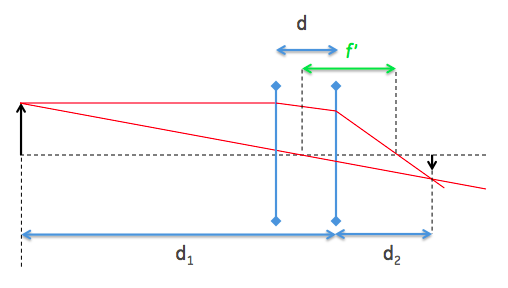Assume two people have identical (size) eyes, but one has a weaker lens than the other. In order to see an object at a certain distance properly, this person needs a second lens to get the focus. This lens will typically be some distance in front of the eye (not touching). If I understand your question correctly, you are asking whether that results in an image on the retina that is the same size, or not.
The simplest way to analyze this is to assume that the person who needs glasses has "no lens at all" - that is, their glasses have to take the role of the lens in the eye. In that case, it's easy to see that if the focal length of the lens-in-the-eye of the normal eye is $f$, and the glasses are $d$ away from the optical center of the lens, then the lens for the second person has a focal length of $f+d$. Now the magnification is approximately proportional to the focal length (for objects that are much further away than the focal length of the object), so in this case the second person (with the glasses) sees an image that is $\frac{f+d}{f}$ times larger than the person with the healthy eye. In reality, the second lens is only contributing a small amount to the focusing, and therefore the magnification will be much smaller.
That is the case for a person with hyperopia (farsightedness). The same analysis for a person with myopia (nearsightedness) will show that they see a slightly smaller image than the person with the healthy eye.
UPDATE While the above explanation is nice for giving a quick intuitive answer, I realize that it might be helpful to show the math for a two-lens system. I will do it with similar assumptions as I used earlier: the size of the eye is unchanged, and an object at a certain distance $d_1$ is imaged in focus on the retina; but in one case this is done with a single lens of focal length $f$, and in the second case there is an additional lens that is a distance $d$ in front of the eye; and it's the combination of the two lenses that produces an object in focus on the retina.
Here is the diagram for the unaided eye:

We know that $$\frac{1}{f}=\frac{1}{d_1}+\frac{1}{d_2}$$
and the magnification (minification) is
$$m = \frac{d_2}{d_1}$$
For the aided eye, the diagram looks like this:

But it's quite hard to construct the optical rays properly without making a very confusing diagram. Therefore, I am going to split the analysis in two parts. First, I will demonstrate that the secondary lens produces a magnified image "further away" - and that this makes it possible for the weaker eye lens to focus. We can then compute the size of the image that the eye lens produces as though the other lens is not there:

I constructed a virtual image of height $h'$ at some distance $s$ from the eye lens. For this, I have assumed a focal length of the eye $f_1$ (not shown), and focal length for the auxiliary lens $f_2$. The distance of the virtual image is calculated from the usual lens formula:
$$\frac{1}{f_2}=\frac{1}{d_1-d}+\frac{1}{s-d}$$
Solving for $s$, we obtain
$$s = \frac{f_2(d_1-d)}{(d_1-d)-f_2}+d$$
This will be a negative number for the situation drawn, where we have a virtual image (namely, the object is in focus on the "wrong" side of the lens).
The height $h'$ of the virtual object is given (from simple geometry) by
$$h' = h \frac{s-d}{d_1-d}$$
Now we can consider the size of an object of height $h'$, at a distance $s$ from a lens with focal length $f_1$. The object will be projected on the retina in-focus (that's how we defined $f_1$ and $f_2$), and the retina is still at distance $d_2$ as before. It follows that the size of the object on the retina is now
$$h' \frac{d_2}{s} = h\frac{s-d}{d_1-d}{d_2}{s}$$
We can do a first order expansion to find out how this is different from the size for the unaided eye, which was $h\frac{d_2}{d_1}$.
$$\begin{align}m&=h\frac{s-d}{d_1-d}\frac{d_2}{s}\\
&\approx h\left(1-\frac{d}{s}\right)\frac{d_2}{d_1}\left(1+\frac{d}{d_1}\right)\\
&\approx h\frac{d_2}{d_2}\left(1-\frac{d}{s}+\frac{d}{d_1}\right)\\
&\approx h\frac{d_2}{d_1}\left(1-\frac{d\left(f_2-d\right)}{f_2 d} + \frac{d}{d_1}\right)\\
&= h\frac{d_2}{d_1}\left(1+\frac{d}{f_2}\right)\end{align}$$
And there it is. The last term represents the additional magnification due to the auxiliary lens. It is directly related to the ratio of the focal length of the auxiliary lens and the distance between that lens and the eye. So if you have a +2 diopter lens (focal length = 50 cm) at 1 cm from the eye, you get a 2% change in apparent size (size of projected image on the retina is 2% larger). That is noticeable, but not massive. Negative focal lengths will make objects appear smaller according to the same formula.
Note that if you have a "good" eye, but choose to wear (reading) glasses anyway to see close up, the lens in your eye will relax, and let the external lens do more of the work. In the process, the image will get larger. And the further your push the glasses to the front of your nose, the greater the magnification. That effect is strongest with stronger glasses, since the additional magnification depends on the ratio of distance and focal length: if you put +3 diopter glasses at the tip of your nose (say 6 cm from your eye) you will get approximately a 20 % magnification
Some additional information about optical construction with compound lenses can be found at this link







